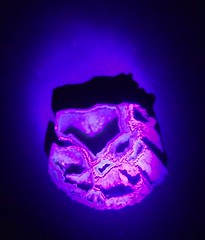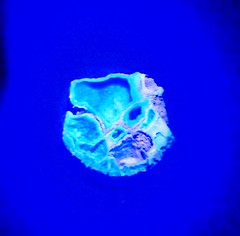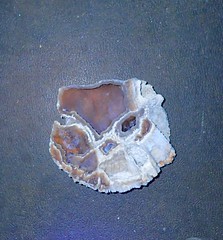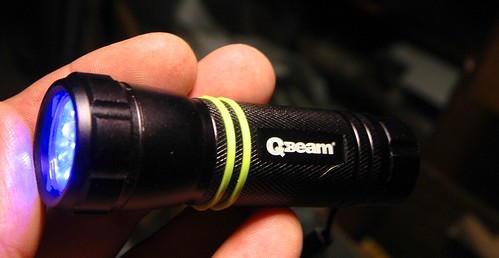jamesp
Cave Dweller 
Member since October 2012
Posts: 36,612
|
Post by jamesp on Mar 7, 2017 7:12:06 GMT -5
This botryoidal filled coral pseudomorph is not behaving. Perhaps a film camera would get the job done. The botryoidal lining is dead yellow using naked eye, very distinct. NOT w/digital camera. Tried all the standard white balance settings. A good thing, as I can spots bots in the field on gravel bars. They are camouflaged in daylight. Have to think about collecting at night on the coral rivers considering food chain. Thrill seeking days are coming to a close. But dialing in digital camera to photo what eye sees may be difficult. any tips ? Rock looks nothing like these photos dang it. Each cavity has a fine yellow surround.    check out this $3 LED inferred flashlight. Wife bought it not knowing it is UV. It sets those bots on yellow fire.  |
|
|
|
Post by Garage Rocker on Mar 7, 2017 7:49:24 GMT -5
There is an IR filter in front of your digital sensor. Some cameras are modded to remove that sensor. One can do it if they know what they are doing. I'm sure there's a YouTube on it. There are also UV filters at sensor and in optical glass lens. You will get something different than what your eye sees. Film camera not as bad, no IR filter.
|
|
jamesp
Cave Dweller 
Member since October 2012
Posts: 36,612
|
Post by jamesp on Mar 7, 2017 7:51:30 GMT -5
|
|
jamesp
Cave Dweller 
Member since October 2012
Posts: 36,612
|
Post by jamesp on Mar 7, 2017 7:56:00 GMT -5
There is an IR filter in front of your digital sensor. Some cameras are modded to remove that sensor. One can do it if they know what they are doing. I'm sure there's a YouTube on it. There are also UV filters at sensor and in optical glass lens. You will get something different than what your eye sees. Film camera not as bad, no IR filter. Was hoping you may chime Randy. Yes, a youtube research. Thanks. Scanned a few tech articles. Will have to incubate on the subject. Pay attention, shortwave LED flashlights (long wave too) can show up agates. I believe one of them shows calcite as yellow. Calcite a player in fortified agates I believe. This is what I was seeing(calcite under shortwave). This is how the botryoidal coatings were illuminated.  |
|
|
|
Post by Garage Rocker on Mar 7, 2017 8:05:45 GMT -5
The fluorescence is still way cool. It's just hard for that sensor to replicate what our eye sees in those wavelengths. Removing the IR sensor is big in astrophotography, if I remember correctly.
|
|
jamesp
Cave Dweller 
Member since October 2012
Posts: 36,612
|
Post by jamesp on Mar 7, 2017 8:14:19 GMT -5
The fluorescence is still way cool. It's just hard for that sensor to replicate what our eye sees in those wavelengths. Removing the IR sensor is big in astrophotography, if I remember correctly. Article said something about film cameras being much more friendly for UV. Digital sensors not designed to see UV well at all as you insinuated. Tried photo shop manipulation to no avail. Bet your Kentucky agates would respond. |
|
|
|
Post by orrum on Mar 7, 2017 8:21:53 GMT -5
I so need a UV light! You can rockhound with one in the desert but it has to be a strong expensive one. Also something about shortwave and longwave. Scorpions are supposed to light up!
|
|
|
|
Post by Garage Rocker on Mar 7, 2017 8:26:36 GMT -5
I may have to break out the old Canon A1 and do some side by side comparison shots. Now, where does one buy film these days???
|
|
|
|
Post by Garage Rocker on Mar 7, 2017 8:28:14 GMT -5
Fluorite is often hounded at night with UV.
|
|
|
|
Post by Garage Rocker on Mar 7, 2017 9:07:11 GMT -5
The fluorescence is still way cool. It's just hard for that sensor to replicate what our eye sees in those wavelengths. Removing the IR sensor is big in astrophotography, if I remember correctly. Article said something about film cameras being much more friendly for UV. Digital sensors not designed to see UV well at all as you insinuated. Tried photo shop manipulation to no avail. Bet your Kentucky agates would respond. KY calcite under UV 
Did you see this page?
Fluorescent rocks
|
|
jamesp
Cave Dweller 
Member since October 2012
Posts: 36,612
|
Post by jamesp on Mar 7, 2017 9:12:15 GMT -5
Article said something about film cameras being much more friendly for UV. Digital sensors not designed to see UV well at all as you insinuated. Tried photo shop manipulation to no avail. Bet your Kentucky agates would respond. KY calcite under UV 
Did you see this page?
Flourescent rocks
Nice film destruction 'Fluorescent Rocks'. Nice references and comparisons. Apparently calcite does all kind of colors. The pandora's box on 'how to photograph' is next step. |
|
Deleted
Deleted Member
Member since January 1970
Posts: 0
|
Post by Deleted on Mar 7, 2017 9:48:19 GMT -5
Actually a UV filter helps with UV fluorescent photography. Filters out UV so the chip can see the fluorescent visible light colors. Bright yellow under long wave UV?!?! rockncajun Ray any clue what that is? |
|
jamesp
Cave Dweller 
Member since October 2012
Posts: 36,612
|
Post by jamesp on Mar 7, 2017 10:20:20 GMT -5
Actually a UV filter helps with UV fluorescent photography. Filters out UV so the chip can see the fluorescent visible light colors. Bright yellow under long wave UV?!?! rockncajun Ray any clue what that is? I am guessing my light is shortwave Scott, but not sure. From images, my coral psuedo's except i was getting yellow/pink(instead of green) for the chalcedony botryoidal layer. Not sure if this is SW or LW  |
|
Fossilman
Cave Dweller 
Member since January 2009
Posts: 20,723 
|
Post by Fossilman on Mar 7, 2017 12:37:14 GMT -5
|
|
Fossilman
Cave Dweller 
Member since January 2009
Posts: 20,723 
|
Post by Fossilman on Mar 7, 2017 12:57:32 GMT -5
There is an IR filter in front of your digital sensor. Some cameras are modded to remove that sensor. One can do it if they know what they are doing. I'm sure there's a YouTube on it. There are also UV filters at sensor and in optical glass lens. You will get something different than what your eye sees. Film camera not as bad, no IR filter. Was hoping you may chime Randy. Yes, a youtube research. Thanks. Scanned a few tech articles. Will have to incubate on the subject. Pay attention, shortwave LED flashlights (long wave too) can show up agates. I believe one of them shows calcite as yellow. Calcite a player in fortified agates I believe. This is what I was seeing(calcite under shortwave). This is how the botryoidal coatings were illuminated.  This one is knock your socks off "COOL"!!!!!! |
|
QuailRiver
fully equipped rock polisher
  
Member since May 2008
Posts: 1,640
|
Post by QuailRiver on Mar 7, 2017 13:06:21 GMT -5
Just as a safety reminder - U.V. light rays can be very damaging to the eyes. I once met and old retired lapidary dealer who liked to use his U.V. light on rocks and gems and had seriously damaged his center-field of vision. When looking straight ahead he could only see what was to his left-of-center and right-of-center fields of vision. Not what was straight in front of him. There are clear U.V. protective safety glasses that will help prevent eye damage when using U.V. lights. Harbor freight sales a pair for $4.99. www.harborfreight.com/safety-glasses-clear-98366.htmlLarry C. |
|
jamesp
Cave Dweller 
Member since October 2012
Posts: 36,612
|
Post by jamesp on Mar 7, 2017 14:03:57 GMT -5
I have the same UV light James.... Wife bought it for me,it really "POPS" those Geodes and thundereggs..... I know I can get better graphics with a better system,but it's sure fun to be playing around with the ideas!!!     You nailed those photos Michael. Do you use that light for field collecting ? Darn thing has good power. For some reason geodes seem to glow. Thundreggs may be similar. |
|
jamesp
Cave Dweller 
Member since October 2012
Posts: 36,612
|
Post by jamesp on Mar 7, 2017 14:06:07 GMT -5
Just as a safety reminder - U.V. light rays can be very damaging to the eyes. I once met and old retired lapidary dealer who liked to use his U.V. light on rocks and gems and had seriously damaged his center-field of vision. When looking straight ahead he could only see what was to his left-of-center and right-of-center fields of vision. Not what was straight in front of him. There are clear U.V. protective safety glasses that will help prevent eye damage when using U.V. lights. Harbor freight sales a pair for $4.99. www.harborfreight.com/safety-glasses-clear-98366.htmlLarry C. Thanks for the safety note Larry. That is a shame about his vision. Never knew such glasses existed. |
|
rockncajun
spending too much on rocks
 
Member since September 2009
Posts: 344
|
Post by rockncajun on Mar 7, 2017 14:06:29 GMT -5
Those inexpensive LED flashlights are around 385 nm, which do emit long wave colring. But true long wave is 365nm. Those lights are much more expensive and harder to find. Someone on this thread mentioned a short wave flashlight. I do not think a shortwave flashlight has been made yet.
|
|
jamesp
Cave Dweller 
Member since October 2012
Posts: 36,612
|
Post by jamesp on Mar 7, 2017 14:54:03 GMT -5
|
|